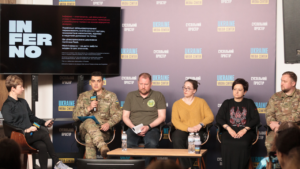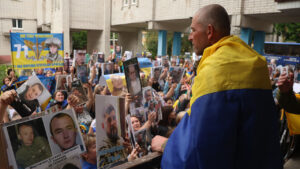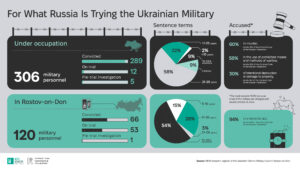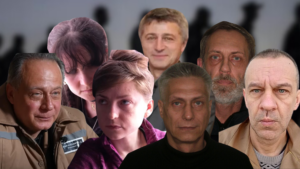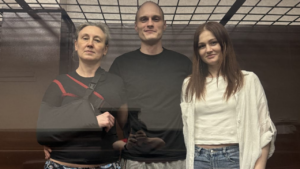A temporary center. How Ukrainian prisoners went through Shebekino
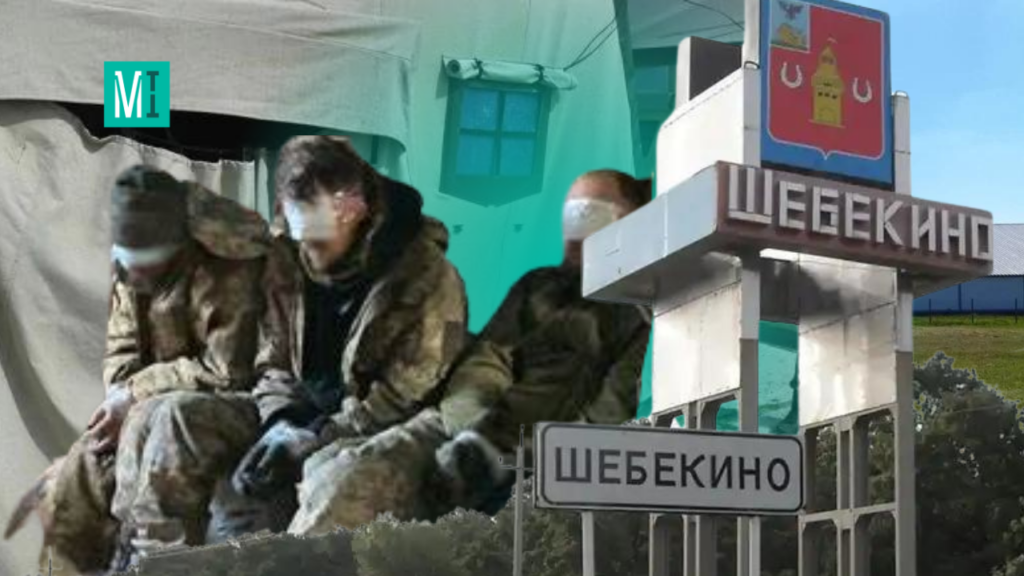
In Ukraine, the Russian town of Shebekino in the Belgorod region is primarily known for news about shelling of the Russian territory. It is located seven kilometers from the border and has a checkpoint near the village of Pletenivka in the Kharkiv region. At the onset of Russia’s full-scale invasion Shebekino was expected to receive Ukrainian refugees. However, the expectations did not materialize, so the Russians quickly found another role for the town. MIHR continues documenting the testimonies of those released from captivity. This time we are talking about a camp in Shebekino.
The first prisoners from the Snake Island
Leonid is the chaplain of the 35th Separate Marine Infantry Brigade. He became a spiritual father for the military in 2014, feeling the calling to be on the front lines. Also driven by the calling, on 26 February 2022 he set off for the Snake Island to retrieve the bodies of the fallen Ukrainian border guards. He went on a search and rescue mission on the ‘Sapphire’ ship. On the same day, despite the humanitarian purpose of the mission and his priesthood, Leonid was taken prisoner by the Russians. It happened near the Snake Island.
“We were brought to Simferopol and put on a transport plane. There were about 200 people on board,” recalls Leonid listing the ‘origins’ of the POWs. “There were the ‘Sapphire,’ fighters from the Snake Island, and people from near Kherson.”
The prisoners were told they were being taken for an exchange, but that was a lie.
The IL-76 aircraft that transported the POWs landed in Kursk. It was minus 22 degrees Celsius outside, and the POWs were in light clothing (it was already warm in southern Ukraine). They were allowed to use the restroom at the airport. After that, the prisoners were put into vans with 40 people in each van and taken away. As it later turned out, they headed to Shebekino. The journey took about three and a half hours. These people had become the trailblazers, the first ones to be brought to Shebekino, as one of the released prisoners put it. They witnessed how a ‘refugee shelter’ was transformed into a prisoner-of-war camp, with a fence erected around the tents.

Shebekino checkpoint. Photo from public sources
The ‘reception’ was harsh: the prisoners had their arms twisted and heads pushed down so they could not see anything, and were led to interrogations and settlement. For the next four days, Leonid became ‘number 139.’
They were placed in tents that the Russians had prepared in anticipation of Ukrainian refugees. Shebekino turned out to be a temporary camp before the prisoners were taken to pretrial detention centers of the nearest towns. This was done gradually, and units and groups of captive Ukrainian soldiers were dispersed to different detention facilities. On March 16 Leonid was transported to Pretrial Detention Center No. 2 in Stary Oskol, Belgorod region.
“They said they had prepared a place for us,” recalls Leonid. “They told us that it would be warm there and that we would be washed and given fresh clothes.”
Leonid was released during the third exchange on 9 April 2022. Along with him, 25 more people were freed from captivity.
Conditions
Volodymyr was also among the first POWs from the Snake Island. He fell into the hands of the Russians on the first day of the full-scale invasion and returned home after long eight months, even though he had anticipated to be exchanged since the first days of being taken POW.
“There were ordinary military tents with about 20-21 people in each,” he says.
He was provided with warm clothing, namely a jacket and socks. Volodymyr spent three days in Shebekino, and on 15 March, same as chaplain Leonid, he was taken to Pretrial Detention Center No. 2 in Stary Oskol. Despite his short stay in Shebekino, he recalls:
“There were no complaints against the Russian military. When they took us captive, they said, ‘Treat a prisoner of war the way you want to be treated.’ We encountered reasonable military personnel.”
Ivan, another POW from among the first captives, had worse impressions:
“They brought us there on 12 March. It was members of the DPR who dug the holes for the posts and stretched the barbed wire. They shouted that they were from the DPR and that they would bite our heads off.”
All tents had folding beds, standard military blankets, and stoves. We were not allowed to go outside or peek out of the tent. We were taken outside three times a day: in the morning, at lunch, and in the evening. First we were taken to the loo, then we were taken to have a meal. Everything had to be done quickly. We were only allowed to move outside bent at a 90-degree angle and holding our hands in a chain so that we had no chance to see what was around. We could go out for firewood from time to time.

Russian military tents. Photo by “RIA Novosti,” a Russian propaganda media outlet
Another prisoner of war, Oleksandr, was captured in March in the Chernihiv region and spent two weeks in Shebekino. He figured this out with the help of a shower, which was allowed to be taken once a week. However, being kept alone in a tent brought about discomfort rather than provided space:
“There were many prisoners in other tents and they arranged shifts among themselves — while some were heating the stove, others could rest. I had to do everything by myself,” recalls Oleksandr.
“I barely slept and could not tell when it was day or night. At some point I couldn’t stand on my feet and I asked for help. A medic came and said, ‘What did you expect? Your feet have been frozen for several days, so it would take a long time for them to recover. Keep them warm and dry.’ And that was it. He just had a look and didn’t provide any help.”
Oleh from the Sumy region was taken to Shebekino on 10 March 2022. He recounts that Russian border guards handed them over to the military police. In the tents, they were accommodated according to rank, i.e. officers with officers, civilians with civilians, etc. The wounded and contract soldiers were accommodated separately.
“One could say they treated us humanely, more or less normal compared to others,” recalls Oleh who spent three days in the camp.
“They told us not to worry, saying that they would interrogate us, and that in three days there would be a change in power in Ukraine and we would be released home. They said, as always, that we were brotherly nations, that we should stick together, that the leadership of Ukraine had fled, that we didn’t let them live normally, and that they would change everything so that we live a normal life with them.”
Some prisoners of war were taken to the surrounding villages to be interrogated by the FSB (the Federal Security Service) officers, some were offered Russian citizenship or jobs in the defense industry. The POWs refused.
Torturing
The further it went, the worse the treatment of POWs in Shebekino became.
Oleksiy was brought to the camp when the fence was already being completed. It took seven hours to transport him to Shebekino from the Chernihiv region. When he was brought in, he was stripped, beaten, baited with dogs, and put on his knees. His personal belongings were taken away. He then was provided with clothing and taken for a conversation with “psychologists,” which seemed more like an interrogation. There was also an interrogation with the FSB officers on the same day.
“There were no personal files like in prison,” recalls Oleksiy. “We stated our full names and dates of birth, but we were assigned no numbers.”
In Shebekino, Oleksiy was forced into physical labor. Starting from the eighth day he had to carry firewood. While bringing firewood into one of the tents he saw private buildings behind the wire and a black brick building of the disciplinary battalion, a place where punishments were carried out.
“The guards noticed that I saw that and beat me up,” remembers Oleksiy.

Ukrainian prisoners of war interrogated by the FSB of Russia. Photo from public sources
Every night the guards kept him on his knees. This happened because he was brought into captivity in Russian thermal underwear, which was given to him by a Russian named Serhiy, who helped ensure that Oleksiy be taken to the camp rather than shot in the Chernihiv region. In the camp, Senior Lieutenant ‘Ratnik’ didn’t believe him. He decided that Oleksiy had forcibly taken the thermal underwear.
Oleksiy remembered well who was with him in the camp: Bohdan, who was beaten for his tattoos; a man whose damaged foot was cut off in captivity; Volodya, a volunteer whom Oleksiy carried in his arms to the hospital; a man with frostbitten feet that began to rot; Serhiy, who had tubes protruding from his chest… All of them were later dispersed to different pretrial detention centers. Oleksiy was released on the eve of the New Year’s Day on 31 December 2022.
Rustam, who was brought to Shebekino in the summer of 2022, was released on the same day. After detention he was held at the checkpoint on the border with the Kharkiv region, where the FSB officers beat those lying down with sticks, hands and feet. Afterward, he was transported to Shebekino.
“People underwent recruitment and FSB interrogations there. It was a kind of temporary center,” says Rustam. “They tried to recruit me and my brother-in-arms as officers. Initially, they recruited for the LDPR and then for the Russian Airborne Forces. There they broke some people down, some people were in panic.”
He and his brother-in-arms refused. Rustam was taken out of Shebekino only in August. He recalls that time:
“The Investigative Committee of the Russian Federation and the FSB repeatedly conducted conversations with me. The FSB has a diverse range of methods: both ‘Kadyrovites’ and ‘tapiks’ were involved. ‘Tapik’ (a field telephone set) is used to connect wires to you to get you electrocuted. If placed on the groin area, a person becomes infertile. If placed on other parts of the body, they would fail. The Russians mainly connected them to the limbs, and I was no exception.”
Having used the electric shocks, they could suffocate you with a bag. Among the torture methods used in Shebekino were soldering irons, rasp files, drugs and waterboarding. Rustam was waterboarded. He was tied to a chair and flipped parallel to the ground with a towel placed on his face. One Russian held him, another poured water so that it entered the nose and mouth.
Vasyl, who was taken prisoner of war in the Kharkiv region in April 2022, was released in 2023. He spent a year in captivity, and his torments also began in Shebekino. He recalls being daily beaten by electric shock prod as the Russians tried to find out the location of Ukrainian Tochka-U missiles.
***
Former prisoners of war mostly refer to their time in the camp as a ‘paradise’ compared to other detention facilities to which they were subsequently transported. After Shebekino, POWs were transported to either Stary Oskol in the Belgorod region or Kursk.
There has been no information about the Shebekino camp since 2023. MIHR assumes that it has been shut down.
Oksana Rasulova, MIHR journalist
This article was written with the support of the European Union and the International Renaissance Foundation as part of the “European Renaissance of Ukraine” joint initiative. The views and opinions expressed herein are that of the authors and do not necessarily state or reflect those of the European Union or the International Renaissance Foundation.


